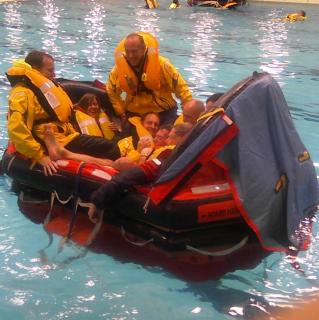Retiring Safety Gear from the list
The 2015 meeting of the International Sailing Federation, now known as World Sailing, was held in Sanya, China. One of the committees that met was the Offshore Special Regulations committee, which is responsible for creating equipment rules for six categories of sailboat racing, based on the proximity to rescue and the duration of the event. The Offshore Special Regulations have grown over the years: in fact, the 1982 version published by the then-United States Yacht Racing Union fit on a single sheet of paper. By 2014, the OSRs, as they are known, had grown to over 200 pages.
It’s interesting to consider why a relatively simple document like the 1982 version would grow to be a bloated, complicated, and ultimately undesirable document that tormented yacht owners, boat captains, and pre-race inspectors due to its incomprehensibility. One could argue that a wide range of new products have come to the market since 1982, and many of those items have greatly reduced the risks of going offshore, or even along the shore. Who wouldn’t want to have an EPIRB, a high buoyancy inflatable life jacket, GPS, AIS transceivers, satellite telephones, VHF radios with Digital Selective Calling, even if it caused the page of requirements to become a small booklet of requirements?
Items tend to be added to the Offshore Special Regulations with relatively little debate about their merits compared to either not adding them
Items tend to be added to the Offshore Special Regulations with relatively little debate about their merits compared to either not adding them, or exchanging them for other items. When AIS became available a few years ago, I can imagine that most offshore sailors felt that the ability to know the location of AIS-equipped vessels was absolutely worth the cost of adding an AIS receiver or transceiver. How could it not be the right thing to do? What about improved safety harness tethers that would have different snaps at each end, and a dated tag that showed when it was purchased, and a overload indicator that would show when the tether had been subjected to a large load (undefined, as it turns out, in the Special Regulations).
Sometimes the new items or technologies obsolete some thing that is already bought and paid for and on the boat. If we’re lucky, the new technology is given a few years of lead time before it’s required, and the old items are allowed for a few years of additional use before being relegated to the rubbish bin or marine flea markets. But it’s always hard to resist new pieces of kit, since everyone worries that if only one life is saved with the new gear, then it will have been worth it.
It was somewhat amazing that one of the submissions presented in Sanya was to eliminate the carriage of SOLAS rocket parachute flares on offshore race boats
Thus, it was somewhat amazing that one of the submissions presented in Sanya was to eliminate the carriage of SOLAS rocket parachute flares on offshore race boats. Instead of having six relatively expensive pyros on board, Category 1 boats would not have any. Not only are these flares dated, with an expiration date of 42 months, but they are virtually impossible to recycle or ship, and they have relatively few instances where they have been the critical alerting device in rescues. Remarkably, the Offshore Special Regulations committee voted to remove the need to carry these devices, showing a reversal of the trend to add consistently rather than to have each item fight for its place on the list of gear.
This raises the obvious question: how DO you decide what gear should be voluntarily carried, or require it to be carried, when sailing offshore? Is more always better? Are you playing fast and loose with the safety of your crew when you elect to not carry a piece of gear?

(Photo Dan Nerney)
Let’s look at an example. Most of us would not consider voyaging down the coast of California and certainly not to Hawaii without carrying a life raft. But is this a logical choice? Life rafts cost around $4,500, require periodic maintenance that might amortize out to $200 per year, and last about 15 years. Total cost per year of ownership: $500 per year. But how many U.S. sailors are saved by life rafts every year? It’s a tiny number: perhaps 20 in a particularly bad year, and perhaps fewer than 10 in a good year. Is it worth it, ignoring the obvious argument that, “if it were your family, you’d sure want to have one if the boat sank” which is always going to be raised. A better argument that lacks some of the emotion is “what alternative do you have if your boat burns or sinks?” A life raft is nearly the only choice.
Let’s return to SOLAS rocket parachute flares. How may sailors are saved by this item, considering that they may have VHF radios, hand flares, EPIRBs, SEND devices, Iridium phones, strobe lights, spot lights and on and on? Perhaps parachute flares have fallen prey to the improving technologies that we all embrace, especially the ability to communicate over the horizon to either rescue networks or rescuing vessels. Perhaps, in this case, we can confidently retire these devices, and their frequent replacement, hazardous waste disposal, and potential to harm the B&G masthead unit, and feel confident that we’ve evolved beyond technologies that were more appropriate for the Titanic generation. As the song says, breaking up is hard to do, but sometimes it’s the right thing to do.
CCA Safety Moment
Chuck Hawley, SF Station, February 2016


